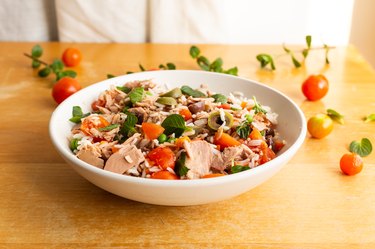
Canned foods are incredibly convenient: They're shelf-stable, budget-friendly and (often) ready-to-eat (read: They make mealtime a breeze). And contrary to popular belief, many kinds of canned foods, such as beans and veggies, are very nutritious.
But of all the good-for-you canned foods available, there's one you should always have on hand: We're talking canned light tuna, people.
Video of the Day
Video of the Day
When you have canned tuna in the pantry, you always have a quick, protein-rich meal at your fingertips, says Leslie Langevin, RD, author of The Anti-Inflammatory Kitchen Cookbook and co-owner of Whole Health Nutrition.
That's probably why canned tuna is the third most popular seafood in the U.S., according to the National Fisheries Institute.
Read on to learn why eating canned light tuna — over other types of tuna — is a terrific way to get all the nutrients of fresh fish (at a fraction of the price).
Canned Light Tuna vs. White Tuna
“Light tuna refers to the species of tuna used, which is usually yellowfin and/or skipjack,” says Susie Polgreen, RD, CD with Whole Health Nutrition. “The meat is darker in color and has a softer texture compared to white albacore tuna,” Polgreen says.
Bonus: Smaller species like yellowfin and skipjack (light tuna) serve up less mercury than larger white albacore tuna (more on this later), Langevin says.
The Benefits of Canned Light Tuna
1. It’s High in Omega-3s
"One of the best health benefits of tuna is that it contains omega-3 fatty acids, which are a type of fat that the body cannot make on its own," Polgreen says. That means you must get these good-for-you fats from your diet. And eating chunk light tuna is a great way to do that.
"Omega-3s help to reduce inflammation and are strongly linked to cardiovascular and brain health," Polgreen says.
As anti-inflammatory fats, they're also essential for eye and skin health, Langevin adds.
Tip
“You want to choose tuna that is canned in water, not oil, as some of the omega-3s can get lost when draining an oil-packed can,” Polgreen says.
2. It’s a Good Source of Vitamin D
"Canned tuna is one of the few foods that naturally contain vitamin D, which is one of the most important (yet challenging) vitamins to be sufficient in," Polgreen says.
It's true: most of us are lacking in this vital vitamin, with about 42 percent of Americans having a vitamin D deficiency, according to Cleveland Clinic's Mercy Hospital.
But supplying your body with vitamin D is critical as it plays a pivotal role in bone and heart health, immunity and mood regulation, Polgreen says.
One serving of canned light tuna provides 2 micrograms of vitamin D, per the USDA. That's 10 percent of your recommended daily value (DV).
3. It Keeps You Full
While canned tuna is low in calories (142 calories per can), this fantastic fish is quite filling (read: It curbs hunger pangs and keeps your cravings in check).
Canned tuna's satiety factor is related to its rich protein and fat content, Langevin says. That's because both macronutrients are digested slowly, which results in feeling fuller for longer.
A single serving of canned light tuna touts an impressive 32 grams of protein and 1.6 grams of fat (although it may sound like a small amount, it is abundant in omega-3 fatty acids), Langevin says.
4. It Supplies Selenium
With 116.5 micrograms per can (that's 212 percent of the DV), chunk light tuna is a significant source of selenium, per the USDA.
Here's why that's good news for your health: As an essential element of many enzymes and proteins, selenium plays a part in DNA production, reproduction and the metabolism of thyroid hormones, and helps safeguard against cell damage and infections, according to the Harvard T.H. Chan School of Public Health.
5. It's Lower in Mercury Than Other Tuna Types
"Mercury is often the biggest health concern with tuna consumption, as high mercury exposures have been linked to significant central nervous system impairments," Polgreen says.
"While all tuna has some mercury, light tuna is typically lower in mercury than white albacore and thus considered a safer choice," she says.
For reference, the average mercury content of light tuna is 0.12 parts per million of mercury versus 0.32 parts per million of mercury for white tuna, Langevin says.
That's because smaller fish — such as skipjack or yellowfin tuna (typically the type of tuna packed in light tuna cans) — accumulate less mercury in their lives compared to larger albacore tuna (the kind you find in canned white tuna), Langevin says.
Still, both Langevin and Polgreen recommend keeping your intake to around one can per week to limit mercury levels in your diet.
How to Buy Light Tuna
Look for labels with "light tuna" (including yellowfin or skipjack) and stick with varieties that are packed in water (rather than oil) for a leaner option, Langevin says
"Another thing you can do is choose brands that conduct mercury testing, such as Safe Catch ($21 per 6-pack) or Wild Planet ($16 per 4-pack)," Polgreen and Langevin agree.
How to Eat Light Tuna
Here are just a few ways Langevin and Polgreen like to use canned tuna for a nutritious lunch, dinner or snack:
- Make fish cakes by tossing tuna with breadcrumbs, an egg, diced onions, celery and peppers and sauté the patties in olive oil.
- Mix tuna with a 1/2 avocado, a little lemon juice, diced onion and celery and serve over greens.
- Toss tuna with olive oil or avocado oil and herbs and scoop it inside pitted avocados and bell peppers.
- Use tuna as a topper to add more protein to a chickpea pasta.